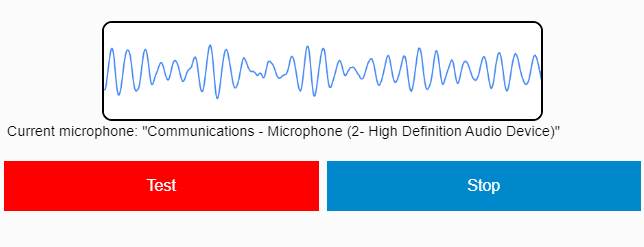마이크 테스트
Use this online mic test tool to check and test the working of your microphone
지침 (마이크 테스트용):
- 클릭 '테스트' 단추.
- 브라우저에 질문이 표시되면 '허용'을 클릭하십시오.
- 이제 마이크를 통해 말할 때 라인이 움직여야 합니다!
라인이 소리에 반응하면 마이크가 작동하는 것입니다!
How our Microphone Testing Tool is Safe to Use?- (Your Privacy Is Very Important To Us)
우리의 마이크 테스트 도구는 개인 정보 보호 기반으로 실행됩니다. "고객 입장에서" – 이는 마이크 테스트 팀이 귀하의 다른 목소리나 기타 유형의 정보를 녹음하지 않으며 녹음할 수도 없음을 의미합니다.
Having Trouble with using our microphone testing tool? Read Further to properly test your microphone.
이 도구를 사용하여 온라인으로 마이크 테스트를 수행할 수 없습니까? 다음은 마이크 테스트를 쉽게 수행하는 데 도움이 되는 단계별 가이드입니다.
* 마이크 테스트 사이트를 처음 방문했거나 기록을 삭제한 후 브라우저에서 이 사이트의 마이크 액세스를 허용할지 묻습니다. 온라인 마이크 테스트를 수행하려면 허용을 선택합니다.
* PC/노트북이 있는 경우 이 질문은 화면 상단의 주소 표시줄 근처에 있어야 합니다.
* 글쎄, 당신이 모바일 장치를 가지고 있다면 끝까지 스크롤하십시오. 선택하는 것으로 나타납니다 허용하다.
* 이제 우리 도구가 마이크 테스트를 수행할 수 있도록 마이크에 무언가를 말해보세요. 그러면 마이크에서 다음과 같은 소리가 들릴 때마다 테스트 상자 영역에서 위아래로 움직이는 선을 볼 수 있습니다.

* 마이크에 대고 말할 때 선이 위아래로 움직이는 것이 보이면 온라인 마이크 테스트가 성공한 것입니다. 마이크가 올바르게 구성되었습니다.
마이크 테스트 문제 해결 가이드
마이크에 대한 액세스를 허용한 후에도 라인이 보이지 않으면 다음 단계를 시도하십시오.
1 단계. 어떤 경우에는 마이크를 테스트하는 동안 줄이 표시되지 않습니다. 이 경우 마이크에 대고 상대적으로 크게 말하고 라인이 나타나는지 확인하십시오.
2 단계. 페이지를 새로고침하고 다시 시도하세요. 대부분의 경우 문제를 해결합니다.
3 단계. 위의 두 단계를 모두 수행한 후에도 마이크가 작동하는지 알 수 없으면 마이크가 장치에 올바르게 연결되어 있는지 확인하십시오.
선은 보이지만 선이 움직이지 않는다면 마이크가 고장났거나 제대로 설정되지 않은 것입니다(더 많은 기회).
문제를 해결하려면 다음 단계를 시도하십시오.
1 단계. 웹 브라우저로 Safari를 사용하는 경우 이 마이크 테스트 웹사이트를 Google Chrome, Microsoft Edge와 같은 다른 브라우저에서 열어야 합니다.
2 단계. 다음으로 마이크가 랩톱/컴퓨터의 올바른(일반적으로 분홍색) 소켓에 연결되어 있는지 확인합니다. USB 커넥터와 함께 사용하는 마이크인 경우 USB 소켓에 제대로 연결되어 있는지 확인하십시오(이 경우 분홍색 마이크는 사용하지 마십시오).
3 단계. 다음으로 마이크가 음소거되어 있지 않은지 확인하십시오.
4 단계. 마지막으로 마이크의 볼륨 레벨이 켜져 있는지 확인하십시오.
마이크 테스트를 온라인으로 시도했지만 여전히 마이크가 작동하지 않습니까? 다음은 몇 가지 솔루션입니다.
Windows 7 또는 Windows 10 마이크가 작동하지 않습니까? 운영 체제에서 마이크 설정 문제를 쉽게 해결하고 마이크가 제대로 작동하도록 할 수 있습니다.
Windows 10에서 마이크 설정을 변경하는 방법
macOS에서 마이크 설정을 변경하는 방법
Windows 8에서 마이크 설정을 변경하는 방법
Windows 7에서 마이크 설정을 변경하는 방법
Ubuntu (Linux)에서 마이크 설정을 변경하는 방법
온라인 마이크 테스트에 대해 자세히 알아보기
이 사이트를 사용하여 온라인 마이크 테스트를 수행하면 어떤 이점이 있습니까?
Skype 또는 Discord와 같은 응용 프로그램을 사용하는 경우 마이크 테스트 기능이 도움이 되지 않을 수 있으며 마이크가 작동하는지 모를 수 있습니다. 이러한 응용 프로그램은 다른 목적으로 설계되었으므로 마이크 테스트를 제대로 수행할 수 없었습니다.
그러나 온라인 마이크 테스트 도구를 사용하면 몇 초 만에 마이크를 쉽게 테스트하여 마이크 연결 문제를 즉시 배제할 수 있습니다.
소프트웨어로 수행한 마이크 테스트의 문제점은 무엇입니까?
마이크가 들리지 않는 것처럼 보이는 소프트웨어에서 마이크를 테스트할 때의 문제는 문제가 소프트웨어에 있는지 아니면 마이크에 있는지 확신할 수 없다는 것입니다.
일부 소프트웨어에서 마이크가 작동하지 않으면 어떻게 해야 합니까?
이 웹사이트에서 온라인 마이크 테스트를 수행할 수 있었고 마이크가 작동하는 것을 발견했지만 여전히 타사 소프트웨어에서 문제를 일으키는 경우 해당 소프트웨어 지원 팀에 문의하는 것이 좋습니다.
문제를 신속하게 해결하려면 mictest.com에서 마이크가 제대로 작동하고 있다고 알려주십시오.
당신은 또한 수 웹캠 테스트 Skype와 같은 비디오 녹화 기반 응용 프로그램을 사용하는 경우.
불일치를 위한 최고의 마이크를 찾고 있습니다 - 여기를 클릭.
가제트에서 가장 비싼 마이크는 무엇입니까? 세계에서 가장 비싼 마이크 7가지를 여기에서 확인하세요.
